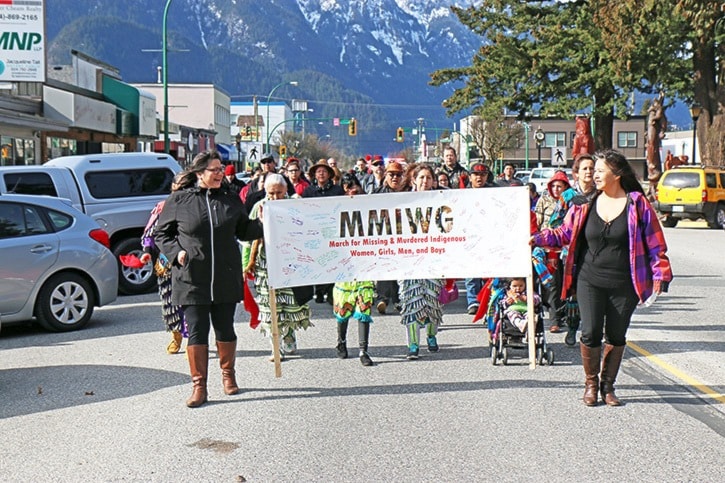Memorial Park hosted the first event of the year, the March for Missing and Murdered Indigenous Women, Girls, Men and Boys (MMIWG), on March 20.
Yale First Nation, Hope and Area Transition Society (HATS), Trails Crossing Friendship Centre and Indian Residential School Survivors Society put together the event that saw First Nations leaders speak to about 100 people at the bandstand before marching to the Hope and District Recreation Centre. Event organizer Margaret Peters said that this event came about because many people could not attend the one in Vancouver.
“There's some family members that are affected by the murdered and missing here in the valley as well,” said Peters. “With the (national inquiry into MMIWG), we wanted to bring more awareness and more attention to the cause and how it affects the families of the missing and murdered.”
Organizers decided that they wanted to include missing and murdered men and boys into the march too.
“You don't hear about it very much, but it has been happening about it for a while,” said Peters.
Cheam First Nation Chief Ernie Crey said having a march that commemorates the men and boys gave him the extra motivation to come.
Crey has advocated for the national inquiry to include an examination for missing and murdered men and boys. He said that statistics show that 70 per cent of indigenous people who have been murdered, gone missing or suffered violence are young indigenous men and boys.
“I just couldn't ignore the issue,” said Crey. “Other Canadians ... need to be [aware of] this as well. We need the complete picture.”
Crey said that including men and boys within the inquiry will allow policymakers to make better decisions for First Nations communities.
Crey recounted the story of his elder brother, Gordon, who died a violent death in Hope.
“There's a cloud of mystery surrounding his death,” said Crey. “I haven't, after all these years, received a report from any authorities in British Columbia about who may be responsible for his death even though I have made inquiries myself down through the years.”
British Columbia has certain hotspots where indigenous people get murdered or go missing. In the north, a section of Highway 16, west of Prince George, is called the “Highway of Tears,” because of the number of cases that happened there. Peters noted that in the south, people go missing and get murdered in Vancouver's Downtown Eastside.
Kalhoose First Nation, based in Cortes Island, Chief James Delorme also attended the event. Delorme attended with Kalhoose elder Mavis Cope.
“We've all had women and men in our lives that have gone missing and that's why we come together like this,” said Delorme. “We'll travel thousands of kilometres to go to events like this.”
He also came on behalf of the B.C. Assembly of First Nations, “to show that the organization, the leadership council cares about our aboriginal citizens in B.C.”
Organizers wanted to host the event on Feb. 14, on the same day the Vancouver march happened. They decided to postpone it a month later because of bad weather.
“It's our first event in Hope that we organized,” said Peters. “I think it's wonderful. I did not expect that many people.”
HATS representative Kathy Abraham pointed out that the first Vancouver MMIWG march only saw a few people in attendance, and the crowd at that Monday's event were larger than that, despite it being the first event.
